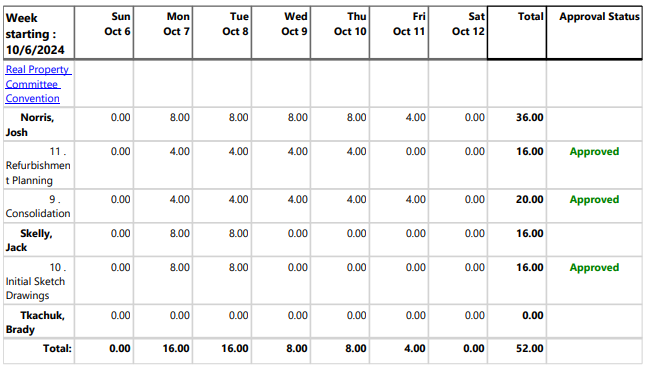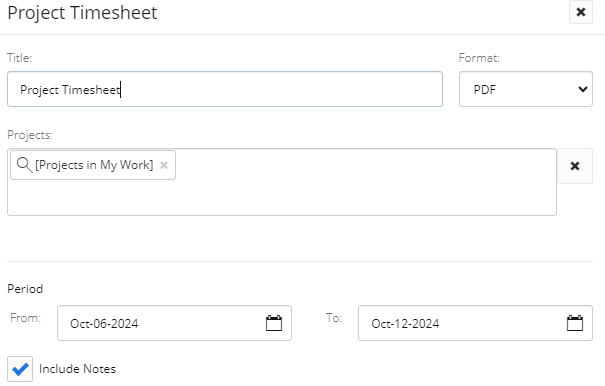Project Timesheet Report
The Project Timesheet report displays Timesheet submission data for specific Projects. This report can be exported as a PDF file, a Microsoft Excel spreadsheet, or a Microsoft Word document.
Each Project included in the report will contain a Timesheet data table for every week included in the selected date range. The weekly Timesheet submission data for each of the Project's Resources will be displayed in the table.

Note: Resources only need to be added to the Project to be included in the report, not necessarily the Project Work Plan.
The table will include rows for each Task that the Resource submitted time against, as well as a row for the Resource's total time submitted toward the Project for the week. A row at the bottom of the table displays the daily and weekly total submitted time by all of the Resources on the Project.
Additionally, users can choose to include Timesheet Notes on the report. These will appear in a new table below the Timesheet data table.

Users can run and download the Project Timesheet report from the Reports page.
Tip: This report can also be run for individual Projects. See Managing Project Reports for more information.
To run the Project Timesheet report:
Before You Start: Projects will only be included in the report if the user running the report has the "Profile Details - View" permission on at least one of the Project's Policies. Additionally, the user will need the "Project Schedule - View" permission on at least one of the Project's Policies in order for Project data to actually appear on the report. Consider this before tasking an Eclipse PPM user with running this report.
-
Select the Reports icon
 from the Navigation Menu.
from the Navigation Menu.
-
Select Project Timesheet from the list of Eclipse Reports.

-
Use the "Project Timesheet" window to customize your Project Timesheet report.

-
Title: Enter a custom name for your Project Timesheet report. This title will appear at the top of the report.
-
Format: Determine whether to export your Project Timesheet report as a PDF file, a Microsoft Excel file, or a Microsoft Word file.
Tip: Excel and Word files are much easier to edit. Users can make adjustments and leave notes on these files before saving them and sending them to others.
-
Projects: Select which Projects will be included in the report by typing in the name of a Project or Project filter and selecting it from the drop-down menu. Repeat this until all of your desired Projects and filters have been added.
Note: These are the same Project filters that can be found on the Project Search page. From here, users can create their own custom Project filters that can be used in the report.
Note: A message will appear if the selected filter(s) will result in no Projects being included in the report.

This could be the result of selecting a filter (or multiple) that does not include any Projects. It could also occur if the user running the report does not have permission to view any of them. -
Period: Use the "From" and "To" fields to determine a date range for the report. Every week included in the date range will be displayed in the report.
Note: If only part of a week is included in the date range, a table for the entire week will be included in the report.
-
Include Notes: Select this checkbox to include tables for each week's Timesheet Notes.
-
-
Select the Run button.

After selecting Run, the report will automatically download onto your device in your selected format.